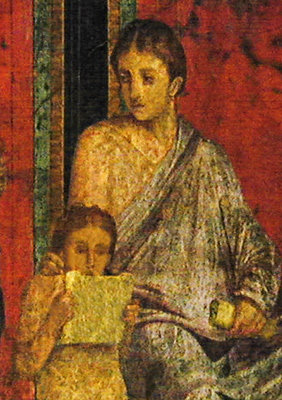 Villa of the Mysteries fresco, Pompeii, 1st C. CE
Villa of the Mysteries fresco, Pompeii, 1st C. CE
 Villa of the Mysteries fresco, Pompeii, 1st C. CE
Villa of the Mysteries fresco, Pompeii, 1st C. CE
It is difficult to assess or generalize with confidence about women's education in ancient Rome. Experience varied with time period, location (urban, regional, provincial), and particularly class. Evidence is haphazard, tends to the anecdotal and extraordinary, and is often prescriptive if not critical, as public displays of learning were popular targets for women's censure. Accomplishments which won praise for a matrona were practical and shifted over time from weaving (Lucretia) to wise maternal counsel (Cornelia) to patronage and benevolence (notably the empresses). Since women could not enter politics or pursue professional careers, upper-class fathers had little incentive beyond affection to provide formal education for the females in their family. Although some attended primary schools (ludi), girls had little time for formal education since marriage could occur as early as puberty. Some may have shared their brothers' tutors, explored their father's library or been instructed by female relatives in areas other than rituals, decorous behavior, and domestic management. While care of the home and moral training of her sons and daughters were the focus of a woman's education during the early Republic, by the first century BCE, with the advent of abundant slaves, all but the poorest households had servants to carry out the tasks involved in upkeep of the domus. Three justifications for educating females gained currency under the Empire: mothers were the first teachers of their children and therefore needed to be as educated as possible (Quintilian, Institutio Oratoria 1.6); education helped women acquire and maintain matronal virtues; possession of educated women was one of the few acceptable forms of family display. While their primary function remained the production of legitimate heirs, young matronae in noble families were afforded opportunities to continue their education — through private tutoring or encouragement by their learned older husbands (e.g., Calpurnia, wife of Pliny the Younger) or through the social and political activities in which their families were obligated to participate. Lower-class freeborn young women would have been trained at home in domestic skills and the family business or sent out to work or apprentice to a trade. For further information on this topic see Hemelrijk (1999), Snyder (1989), and Caldwell (2015) in the Bibliography; see also Images of Learning below.
| Text-Commentaries | Additional Readings |
|---|---|
| M. Valerius Martialis, Epigrammata IX. 68: girls at school | See the Latin reader The Worlds of Roman Women for the following texts: |
| Valerius Maximus, Factorum et Dictorum Memorabilia VIII.3.3: Hortensia | C. Plinius Caecilius Secundus (minor), Epistulae 4.19: Calpurnia's literary leanings |
| C. Plinius Caecilius Secundus (minor), Epistulae I.16.6: a literary wife | M. Valerius Martialis, Epigrammata 3.69.5-8: poetry read in school |
| Valerius Maximus, Factorum et Dictorum Memorabilia VIII.3.2: Afrania | P. Ovidius Naso, Tristia 3.7: Perilla |
| Valerius Maximus, Factorum et Dictorum Memorabilia VIII.3.1: Amesia | C. Suetonius Tranquillus, Vita Divi Augusti 64.2-3: a daughter's training |
| M. Tullius Cicero, De Oratore III.12.45: Laelia | M. Fabius Quintilianus, Institutio Oratoria 1.1.4, 6: eloquent women |
| Sextus Propertius, Elegiae III.23: the lost love tablets | M. Junius Juvenalis, Saturae 6.434-56: the intellectual woman |
| Ambrosius Theodosius Macrobius, Saturnalia 2.5.1-5, 9: Julia, daughter of Augustus | Sulpiciae Conquestio lines 7-11: a woman poet succeeds |
| Q. Horatius Flaccus, Carmina I.11: Leuconoe | |
| C. Plinius Caecilius Secundus, Epistulae 3.3: Corellia Hispulla | |
| C. Valerius Catullus, Carmina 36: Lesbia | See De Feminis Romanis at Diotima for the following on-line Latin texts: |
| M. Cornelius Fronto, Epistulae ad Marcum Caesarem II.2, IV.6: Domitia Lucilla | M. Fabius Quintilianus, Institutio Oratoria 1.1.6: Women's Eloquence |
| P. Cornelius Tacitus, Agricola IV.1-3: Julia Procilla | Vindolanda Letter of Claudia Severa |
All images are courtesy of the VRoma Project's Image Archive.